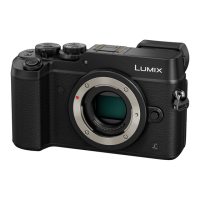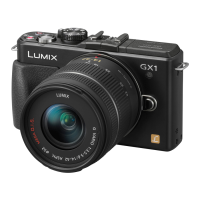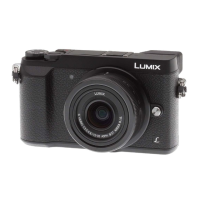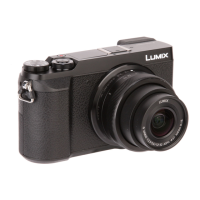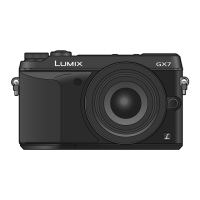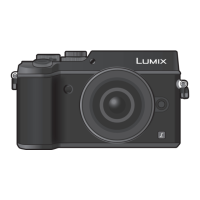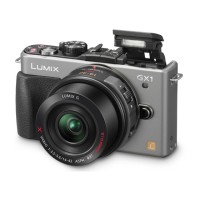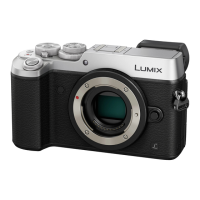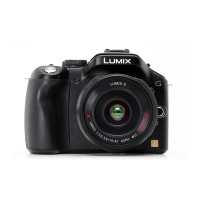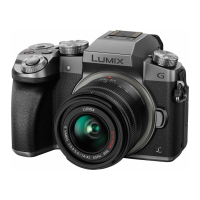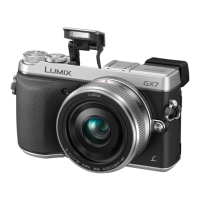
Do you have a question about the Panasonic Lumix DMC-GX7 and is the answer not in the manual?
| Brand | Panasonic |
|---|---|
| Model | Lumix DMC-GX7 |
| Category | Digital Camera |
| Language | English |
Guidelines for protecting the camera from damage, dust, water, and condensation.
Identifies and describes the various buttons, dials, and parts of the camera body.
Details on compatible lens mounts (Micro Four Thirds, Four Thirds, Leica) and lens specifications.
Information on adjusting the angle of the monitor/viewfinder for various shooting positions.
Explains touch operations like touch, drag, and pinch (enlarge/reduce) on the camera's screen.
Details on operating the camera using the rear and front dials for settings and selections.
Procedure for attaching and detaching interchangeable lenses, including alignment marks.
Instructions on how to attach the battery and connect the charger for charging.
Information on compatible SD cards, speed class, and accessing the card.
Step-by-step guide to setting the camera's date, time, and time zone.
Explains how to customize camera operation using touch or button controls via the menu system.
How to access and use the Quick Menu for fast adjustments to common settings.
Guide on customizing function buttons for quick access to frequently used operations.
Details on essential setup menu items like Clock Set and Economy settings.
General advice on holding the camera, stability, and avoiding obstructions.
Explanation of eye sensor switching and manual viewfinder operation.
Step-by-step instructions for selecting recording mode and focusing to take a photo.
Guide on starting and stopping motion picture recording using the dedicated button.
How to use Intelligent Auto and Auto Plus modes for automatic scene and subject settings.
Details on Aperture-Priority, Shutter-Priority, and Manual Exposure modes.
How to apply various image effects and adjust their strength for creative control.
Selecting and adjusting effects like Vivid, Monochrome, and Portrait for desired image quality.
How to set the white balance manually or use auto settings for accurate color reproduction.
Options for setting aspect ratio, number of pixels, and compression rate for images.
Guide to using AF modes like AFS, AFF, AFC, and Face Detection.
Instructions on using manual focus with focus lever or ring, including MF Assist.
How to adjust exposure compensation and flash output for better exposure control.
Options for metering modes: Multiple, Centre weighted, and Spot.
Explanation of drive modes like Single, Burst, Auto Bracket, and Self Timer.
How to set burst speed (SH, H, M, L) and focus for continuous shooting.
Instructions for using the self-timer with different delay and picture count options.
Guide to setting start time, interval, and number of pictures for time-lapse photography.
Steps for creating stop motion videos by splicing sequential pictures.
How to mute camera sounds and disable flash/AF assist lamp for quiet shooting.
Enables silent shooting by disabling the mechanical shutter.
Function to prioritize focus and exposure for registered faces.
Explanation of optical image stabiliser types and compatible lenses.
Using zoom levers, rings, and buttons for optical and digital zoom operations.
Using Extra Tele Conversion to enlarge pictures without degrading quality.
Instructions for opening/closing the built-in flash and understanding flash range.
Selecting flash modes like Forced Flash On, Slow Sync, and Red-Eye Removal.
Guide to selecting record format (AVCHD, MP4), size, and frame rate.
How to capture still photos simultaneously with motion picture recording.
Overview of settings available within the Motion Picture menu.
Options for multi-screen playback, calendar playback, and normal playback.
How to play back pictures grouped by Burst Mode, Time Lapse Shot, or Stop Motion Animation.
Functions for editing images like Clear Retouch, Text Stamp, and Resize.
Procedure to extract a single still picture from recorded motion footage.
How to add location data from a smartphone/tablet to images.
Overview of Wi-Fi and NFC functions, including usage precautions.
Instructions for installing the Panasonic Image App and remotely operating the camera.
Steps for establishing a Wi-Fi connection between the camera and a smartphone/tablet.
Methods for sending images directly from the camera to a smartphone/tablet.
Guide on transferring pictures and motion pictures from the camera to a PC.
How to send images to SNS or cloud services via LUMIX CLUB.
Steps for acquiring a LUMIX CLUB login ID and registering web services.
Instructions for taking and viewing 3D pictures with a compatible lens and TV.
Connecting the camera to a TV via HDMI or AV cable for playback.
Procedure for transferring recorded files to a PC using USB or SD card.
Guide to installing PHOTOfunSTUDIO and SILKYPIX Developer Studio from the CD-ROM.
Steps for connecting to a PictBridge printer and selecting pictures for printing.
Information on optional accessories like external flashes, shutter remote, and filters.
Explanation of on-monitor and viewfinder display elements during recording and playback.
Common confirmation and error messages with their meanings and solutions.
A comprehensive list of all menu items and their corresponding page numbers.
Solutions for common camera issues related to power, recording, focus, and image quality.
Important warnings regarding electromagnetic interference, chemicals, and proper handling.
